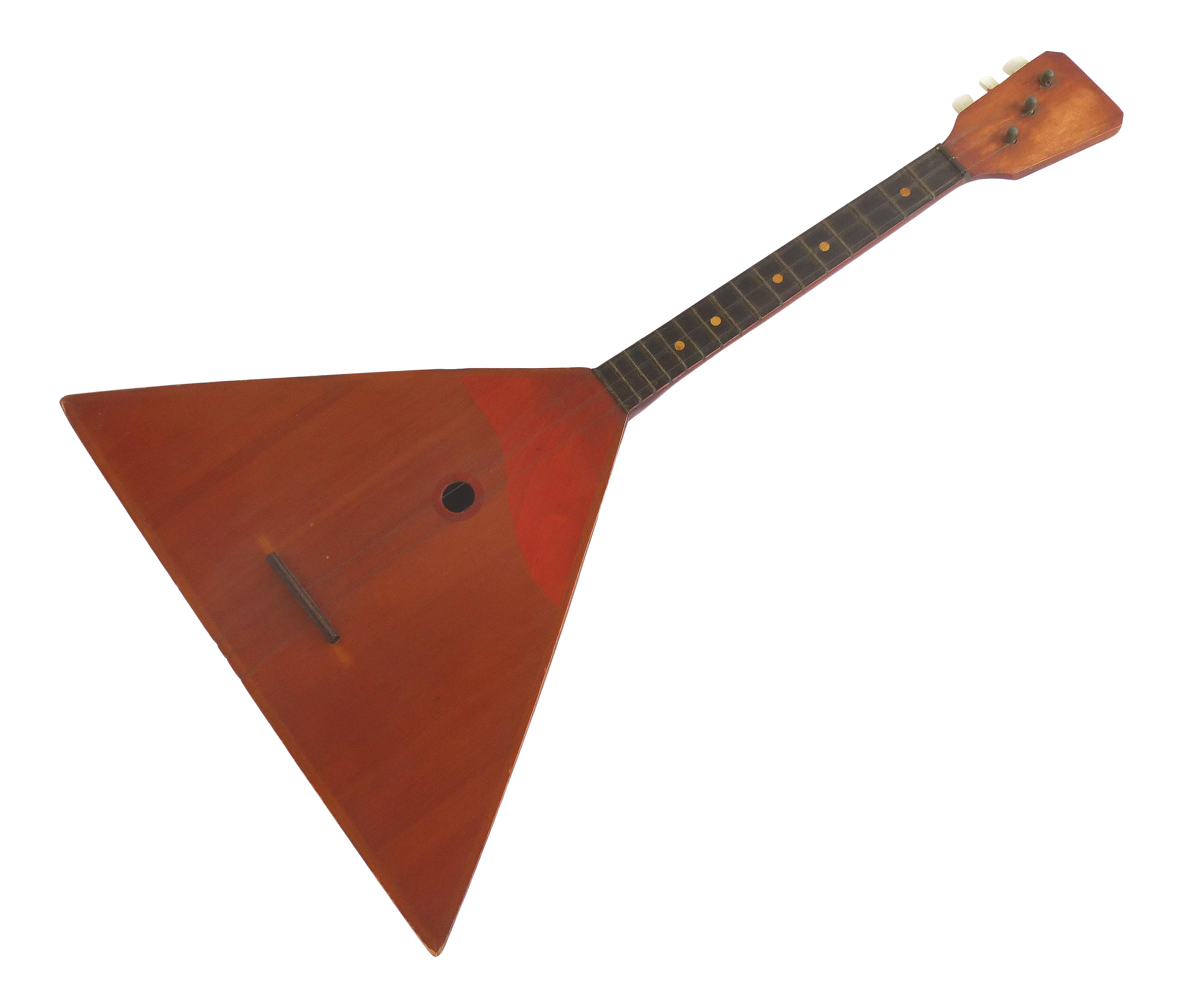 The Balalaika, A traditional Russian guitar. It first made its appearance somewhere between 1688 and the early 1700s. This guitar-like instrument has a distinct sound, somewhere between a mandolin and a ukelele. The Balalaika has been used in solo and orchestral performances and is very popular in Russian folk music.
The Balalaika, A traditional Russian guitar. It first made its appearance somewhere between 1688 and the early 1700s. This guitar-like instrument has a distinct sound, somewhere between a mandolin and a ukelele. The Balalaika has been used in solo and orchestral performances and is very popular in Russian folk music. A few other notable instruments from Russain folk music are the Gudok, another stringed instrument played with a bow, a button accordion call the Bayan and various percussion instruments. There are many instruments used in Russian folk music, most are replications or forms of other popular instruments such as tambourines, flutes, spoons, and even a version of the bagpipe.
Russian Folk is widely known as a very low, chanting sort of music. This stemmed from the Russian Orthodox religion and evolved into folk songs sung throughout daily life, to accompany any daily task. In the mid-1600s, the tsar of Russia, Alexis I of Russia, paired with the Orthodox Church, moved to ban the use of instruments entirely from the country. This caused an instrumental drought for many years, and to this day no instruments are used in Orthodox religion. Folk songs have a very distinct chanting sound, not a very broad range, and largely Accapella. What music is accompanied sounds slightly sad, because of the fact that most songs are written in a minor key. This gives the feel of cold winters and bleak landscape, while still being upbeat.
I for one really enjoy listening to Russian folk music for its uniqueness, and energy. Even with being in a minor key most of the time, it still has a very driving rhythm and is very enjoyable to listen to. It's nice to sit and enjoy the simple but riveting melodies and steady beats of the music.
Russian traditional music. (2020, September 02). Retrieved October 23, 2020, from https://en.wikipedia.org/wiki/Russian_traditional_music
Music of Russia. (2020, October 20). Retrieved October 23, 2020, from https://en.wikipedia.org/wiki/Music_of_Russia
История балалайки. (2015, October 16). Retrieved October 23, 2020, from https://gpvn.ru/balalaika/history
Maes, F. (1970, January 01). A history of Russian music : From Kamarinskaya to Babi Yar : Maes, Francis, 1963- : FreeDownload, Borrow, and Streaming. Retrieved from https://archive.org/details/historyofrussian0000maes


I really enjoyed listening to the Russian folk music samples that you provided. I did not realize that there had been a ban on instruments, that sounds just awful! I will have to look into this further, I'm not familiar with Russian history but it sounds intriguing.
ReplyDeleteThis was really interesting to read because I have not heard anything about Russian music. I didn't know that they had their own kind of guitar. I'm so used to the mainstream American instruments that I forget that other cultures have their own unique instruments. I would like to learn more about why they tried to ban instruments from the country.
ReplyDeleteI listened to your song called Oy Polna, and I really really enjoyed it! You're totally right about the slightly melancholy sound but yet strangely upbeat, it was really cool. One thing you could maybe add is more discussion about the various elements that are in the acapella singing, such as the polyphonic structure in the music, where multiple melodies are happening at the same time. Other than that I agree with all of your points!
ReplyDeleteI enjoyed listening to the selections you made with the music videos. I noticed that when they play instruments, they include a theme to the song. A painting that tells a story, for instance the Russian Folk-Trioka, pictures kept changing thru out the music. Also for Russians to sing, I noticed there is no instruments playing, starts out as Acapella only. Reading your blog about this had me learning about the instruments being banned. I am not sure if its just for the singing part? or just the music itself. I do have family and friends who are Russian Orthodox, and when they do sing, they do not have any instruments starting out the song. It all starts out as Acapella only. The music elements for Ol Polna Polna is Harmony where the singers is using the polyphonic texture, if I hear it correctly all the men is using the Soprano, Alto, tenor and Bass-which is surprising to hear for the men to sing part of the soprano. The dynamics of the song is mixed in both soft and hard.
ReplyDeleteI enjoyed your blog about the Russian Music. I was surprised to read that the instruments were banned for a while. Which reminded me of how eskimo dancing/drumming was banned in our culture for some time and my grandfather was one of a handful of people who helped bring it back to our people. Very interesting to read for sure! I enjoyed the music you chose, they were very easy listening and one reminded me of opera music. I learned that they were inspired German, French and Italian operas were introduced to Russia, which made opera popular in Russia! I agree with everything that you posted!
ReplyDelete